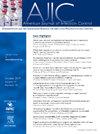对手卫生观察收集的正确尺寸期望。
IF 3.8
3区 医学
Q2 INFECTIOUS DISEASES
引用次数: 0
摘要
背景:手部卫生(HH)监测对患者和工作人员的安全至关重要,但最佳观察次数仍难以捉摸。该项目旨在确定一个统计上可比较的数字,低于目前每个单位每月100至200个的标准。方法:将各医院的HH观察数据按设施、单位和月份分层分组,然后重新抽样为25组、50组、100组和150组,与200组比较。计算显著比较和置信区间宽度差异。考虑到依从率(50%-90%)的功效分析确定了在0.05水平上与200有显著差异所需的样本量。结果:68个设施共873,618个观测值,比较样本量(25,50,100,150)到200,显示2.6%到4.3%的显著差异,P = 0.05,中位置信区间宽度差异为0.05%到0.68%。功效分析显示,P = 0.05时所需的显著性百分比差异范围从7.8% (150 vs 200, 90% HH依从性)到30% (25 vs 200, 50%依从性)。结论:研究结果表明,即使依从性较低,医院也可以将HH观察次数减少到每月每单位50次,而不会影响数据质量。建议将标准的重点从监视(较少观察)转移到培训、教育、文化、基础设施和反馈。本文章由计算机程序翻译,如有差异,请以英文原文为准。
Right-sizing expectations for hand hygiene observation collection
Background
Hand Hygiene (HH) monitoring is essential for patient and staff safety, but the optimal number of observations remains elusive. This project aimed to determine a statistically comparable number below the current standard of 100 to 200 per month per unit.
Methods
HH observations from various hospitals were grouped in strata by facility, unit, and month, then resampled into sets of 25, 50, 100, and 150 for comparison with 200. Significant comparisons and confidence interval width differences were calculated. A power analysis, accounting for adherence rates (50%-90%), identified sample sizes needed for significant differences from 200 at the 0.05 level.
Results
A total of 873,618 observations across 68 facilities, compared sample sizes (25, 50, 100, 150) to 200, showed 2.6% to 4.3% significant differences at P = .05, with median confidence interval width differences from 0.05% to 0.68%. The power analysis showed required percentage differences for significance at P = .05 ranged from 7.8% (150 vs 200 at 90% HH adherence) to 30% (25 vs 200 at 50% adherence).
Conclusions
The findings suggest hospitals could reduce HH observations to 50 per unit per month without affecting data quality even at lower adherence. It is recommended that standards shift focus from monitoring (with fewer observations) to training, education, culture, infrastructure, and feedback.
求助全文
通过发布文献求助,成功后即可免费获取论文全文。
去求助
来源期刊
CiteScore
7.40
自引率
4.10%
发文量
479
审稿时长
24 days
期刊介绍:
AJIC covers key topics and issues in infection control and epidemiology. Infection control professionals, including physicians, nurses, and epidemiologists, rely on AJIC for peer-reviewed articles covering clinical topics as well as original research. As the official publication of the Association for Professionals in Infection Control and Epidemiology (APIC)

 求助内容:
求助内容: 应助结果提醒方式:
应助结果提醒方式:


